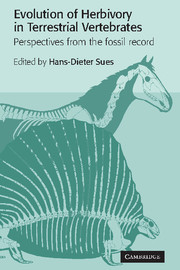Book contents
- Frontmatter
- Contents
- List of contributors
- Preface
- 1 Herbivory in terrestrial vertebrates: an introduction
- 2 Herbivory in late Paleozoic and Triassic terrestrial vertebrates
- 3 Prosauropod dinosaurs and iguanas: speculations on the diets of extinct reptiles
- 4 The evolution of sauropod feeding mechanisms
- 5 Plant-eaters and ghost lineages: dinosaurian herbivory revisited
- 6 Dental constraints in the early evolution of mammalian herbivory
- 7 Patterns in the evolution of herbivory in large terrestrial mammals: the Paleogene of North America
- 8 Origin and evolution of the grazing guild in Cenozoic New World terrestrial mammals
- Taxonomic index
- Subject index
5 - Plant-eaters and ghost lineages: dinosaurian herbivory revisited
Published online by Cambridge University Press: 22 October 2009
- Frontmatter
- Contents
- List of contributors
- Preface
- 1 Herbivory in terrestrial vertebrates: an introduction
- 2 Herbivory in late Paleozoic and Triassic terrestrial vertebrates
- 3 Prosauropod dinosaurs and iguanas: speculations on the diets of extinct reptiles
- 4 The evolution of sauropod feeding mechanisms
- 5 Plant-eaters and ghost lineages: dinosaurian herbivory revisited
- 6 Dental constraints in the early evolution of mammalian herbivory
- 7 Patterns in the evolution of herbivory in large terrestrial mammals: the Paleogene of North America
- 8 Origin and evolution of the grazing guild in Cenozoic New World terrestrial mammals
- Taxonomic index
- Subject index
Summary
Introduction
Biotic interactions, whether they are in the form of hosts and parasites, flowers and pollinators, or seeds and dispersers, are often considered the sine qua non of coevolution, a process that some have argued has an overarching influence on the structure of life on Earth (Futuyma and Slatkin 1983; Margulis and Fester 1991; Thompson 1994). Whether true or not, the identification of coevolutionary relationships can be rather difficult from a paleontological perspective, particularly when considering groups of extinct organisms well removed from those of the present day.
Several attempts have been made to understand plant–herbivore interactions during the Mesozoic, a time when plant-eaters interacted with a mixture of ‘pteridophyte’, ‘gymnosperm’, and angiosperm plants. Virtually all of these studies have begun by grouping co-occurring faunas and floras (e.g., Benton 1984; Hotton 1986; Tiffney 1986; Farlow 1987; Coe et al. 1987; Fleming and Lips 1991). Co-occurrence is either in terms of taxa that may have associated with one another or the features that reflect this plant–herbivore interaction (tooth shape, foliage type, etc.). In more expanded form, these groupings are then examined in light of their paleobiogeographic and temporal distributions to understand their coevolutionary patterns (e.g., Bakker 1978; Wing and Tiffney 1987).
The discovery of patterns of ecological interactions and/or coevolution between plants and herbivores during the Mesozoic is particularly important in view of the great radiation of angiosperms beginning in the latter half of the Early Cretaceous and extending through the end of that period (Doyle and Donoghue 1986; Crane 1989).
- Type
- Chapter
- Information
- Evolution of Herbivory in Terrestrial VertebratesPerspectives from the Fossil Record, pp. 123 - 143Publisher: Cambridge University PressPrint publication year: 2000
- 21
- Cited by



